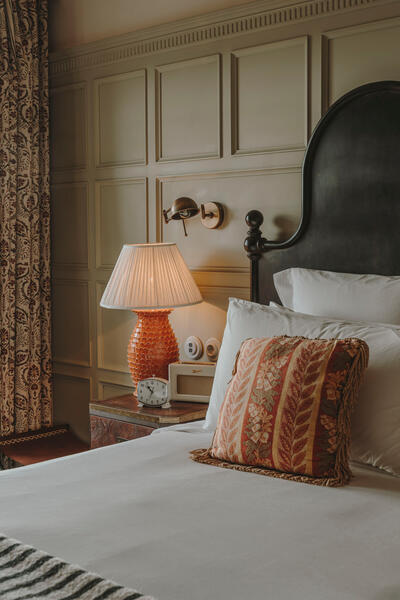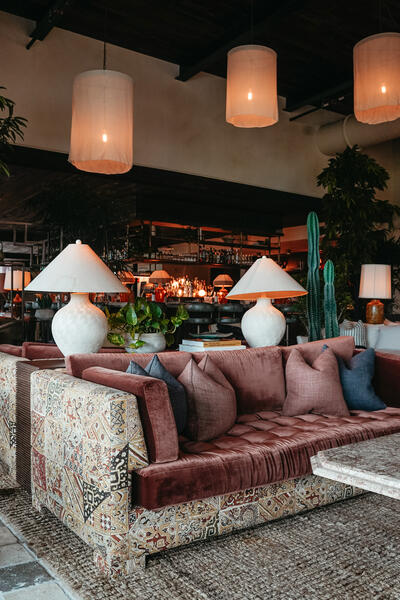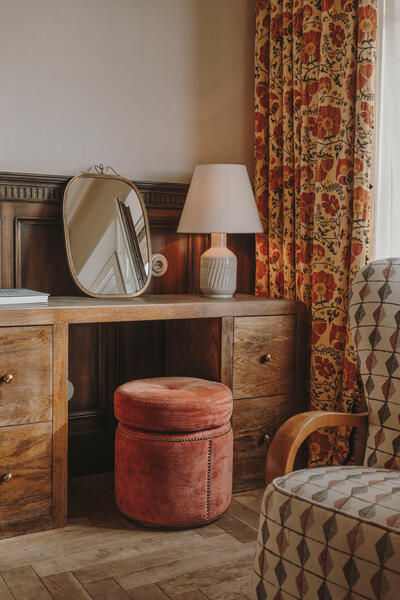By Megan Murray
Good lighting makes a room. In our Houses, we're careful to use a mix of lamps, ceiling lights and wall sconces for an ambient glow.
But, while we recommend the whole trifecta, lamps are the easiest way to skip ahead and create atmosphere. Plus, they can be added or changed at any time.
An instant attraction is more than a good enough reason to purchase a new piece for your home - we love picking up homeware for the Houses on impulse. Even so, if your aim is to build a soft, calming lighting scheme in a living room or bedroom, there are a few things to consider while searching for either a table or floor lamp.
This could involve asking yourself simple questions around the size and shape, or thinking about how a shade's material might affect the colour or strength of the light. Here, our team shares the rules to apply when buying a table or floor lamp for your home.
What size should a table lamp be?
Whether you're looking for a table or floor lamp, different sizes work for different rooms. If the aim is to make a visual impact, then go big and bold, like the Frome. It works well in places that draw the eye, such as a console table in a hallway, a sideboard in a living room, or on top of a dresser in a bedroom.
For spots designed to be functional, a compact lamp is often more suitable. Retro-style table lamps such as the Giovanni or those with an orb instead of a shade, such as the Ayesha or Lakeville, are stylish and understated. Position one on a desk - it won't take up space and projects light well for reading and writing.
Every bed in our House bedrooms is flanked by two side tables, each with a matching lamp. We use this as an opportunity to make a statement with a large patterned shade or interesting base, but at home most people need this space for night-time essentials. The Greyson or Thelma table lamps are good examples of pieces that fill the area nicely, without dominating it.



How big should a floor lamp be?
Floor lamps can subtly enhance the feel of a space, blending into the background while emitting an atmospheric glow, or used as a focal point of the room's design.
Sculptural floor lamps such as the Arc are perfect for the latter. With an elongated, arched frame that stands at 220cm, this lamp needs a lot of space and should sit front and centre in a living room, not tucked behind a chair or sofa. If this is the look you desire, build the room's layout around it and pair with minimal, form-focused furniture.
However, if you plan on creating a reading nook or adding pockets of light to the corners of a space, a vertical frame and simple shade sitting at around 150cm works best. Similarly, for the bedroom, an uncomplicated medium height floor lamp will help it to feel calm and relaxing.


How do I pick the right size lampshade?
Even a lampshade in a very subtle colour or style can make an impact in a room. But, if the size isn't quite right, you'll find that everything looks a little 'off'.
In most cases, if you had to choose between a lampshade that's too large or too little, bigger is always better. A too-small lampshade tends to look like it's teetering on top of its base, as though it's not really supposed to be there.
We work to the rule that the perfect size lampshade should hide the bulb holder, but not too much of the base. For a table lamp, the shade should be about twice the width of the base and about a third of the overall height of the lamp.
How do I choose the fabric for a lampshade?
A lampshade's material isn't just about what appeals most to the eye, but the effect it will have on the light. For a soft, ambient glow, look for a natural material with a slight texture to it. For example, linen and jute in neutral tones provide a flattering light.
If you're looking for a lampshade that's suitable for an area where you need to see clearly, a harder, thicker shade can be beneficial as it encourages a solid beam of light. Or, if you're looking for a shade with a modern aesthetic, try a structured, pleated style in a harder material such as parchment or cotton.



What’s the best way to position lamps around my home?
A three-tier lighting scheme works for most homes and takes into consideration the role of table and floor lamps, wall sconces, and ceiling lights.
A good rule of thumb is to place a floor lamp in the corner of a room, usually behind an armchair or nestled next to a bookcase. Use a statement table lamp on a larger piece of furniture, such as a sideboard or chest of drawers, and smaller table lamps on more restricted surfaces like a side table, coffee table or bedside table.
We always position wall sconces either side of a bed head for symmetry and as reading lights. When looking at a living area, find a central point across the room and position the lights so that they look balanced. They should be equidistant from the central focus, whether it be a fireplace, pendant or chandelier.
Then, finish with a ceiling light to suit the style of the room. For example, a show-stopping chandelier works for a large living room, while a trio of hanging pendants looks great above a dining table.


Do I need to think about hardware?
In all our Houses, we spend a lot of time working out the position of sockets, switches, and lights. This means making basic decisions about the structure of the room, where things are going, and at what height. But it's worth getting this right from the start if you have the chance. A socket in the wrong place might annoy you forever, and easy, convenient lighting makes all the difference.
Put wall lights on one circuit with any other lamps and picture lights, and then have ceiling lights with a dimmer on a separate circuit, so you can adjust the mood. If you don't have the luxury of starting from scratch, add dimmer switches to help create atmosphere.

















